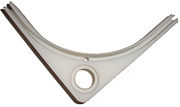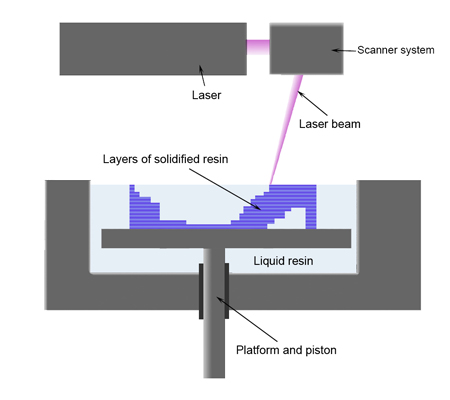Stereolithography
From Wikipedia, the free encyclopedia
|
Part of the series on the |
||
| Woodblock printing | 200 | |
| Movable type | 1040 | |
| Intaglio | 1430s | |
| Printing press | 1454 | |
| Lithography | 1796 | |
| Chromolithography | 1837 | |
| Rotary press | 1843 | |
| Flexography | 1873 | |
| Mimeograph | 1876 | |
| Hot metal typesetting | 1886 | |
| Offset press | 1903 | |
| Screen-printing | 1907 | |
| Dye-sublimation | 1957 | |
| Phototypesetting | 1960s | |
| Photocopier | 1960s | |
| Pad printing | 1960s | |
| Laser printer | 1969 | |
| Dot matrix printer | 1970 | |
| Thermal printer | ||
| Inkjet printer | 1976 | |
| 3D printing | 1986 | |
| Stereolithography | 1986 | |
| Digital press | 1993 | |
Stereolithography is a common rapid manufacturing and rapid prototyping technology for producing parts with high accuracy and good surface finish. A device that performs stereolithography is called an SLA or Stereolithography Apparatus.
Contents |
[edit] Technology description
Stereolithography is an additive fabrication process utilizing a vat of liquid UV-curable photopolymer "resin" and a UV laser to build parts a layer at a time. On each layer, the laser beam traces a part cross-section pattern on the surface of the liquid resin. Exposure to the UV laser light cures, or, solidifies the pattern traced on the resin and adheres it to the layer below.
After a pattern has been traced, the SLA's elevator platform descends by a single layer thickness, typically 0.05 mm to 0.15 mm (0.002" to 0.006"). Then, a resin-filled blade sweeps across the part cross section, re-coating it with fresh material. On this new liquid surface the subsequent layer pattern is traced, adhering to the previous layer. A complete 3-D part is formed by this process. After building, parts are cleaned of excess resin by immersion in a chemical bath and then cured in a UV oven.
Stereolithography requires the use of support structures to attach the part to the elevator platform and to prevent certain geometry from not only deflecting due to gravity, but to also accurately hold the 2-D cross sections in place such that they resist lateral pressure from the re-coater blade. Supports are generated automatically during the preparation of 3-D CAD models for use on the stereolithography machine, although they may be manipulated manually. Supports must be removed from the finished product manually; this is not true for all rapid prototyping technologies.
[edit] Advantages and disadvantages
Stereolithography has many common names such as: 3D printing, optical fabrication, photo-solidification, solid free-form fabrication, and solid imaging. One of the appealing aspects about SLA is that a functional part can be created within one day which becomes useful when working in a “ time is money” environment. However the amount of time to produce any one part depends on the size and complexity of it and can take anywhere from a few hours to more than a day. Most SLA machines can produce parts with a maximum size of 20” x 20” x 24”. Prototypes made by SLA can be very beneficial as they are strong enough to be machined and can be used as master patterns for injection molding, thermoforming, blow molding, and also in various metal casting processes. Although there are almost no limitations when it comes to the shapes of the parts that can be created the process is not by any means inexpensive. The photo-curable resin can cost any where from $300 to $800 per gallon. An SLA machine can cost from $100,000 to $400,000.
[edit] History

The term “stereolithography” was coined in 1986 by Charles (Chuck) W. Hull[1]. Stereolithography was defined as a method and apparatus for making solid objects by successively “printing” thin layers of the ultraviolet curable material one on top of the other. Hull described a concentrated beam of ultraviolet light focused onto the surface of a vat filled with liquid photopolymer. The light beam draws the object onto the surface of the liquid layer by layer, causing polymerization or crosslinking to give a solid. Because of the complexity of the process, it must be computer-controlled.[2] The first company aiming to generalize and commercialize the procedure was founded immediately alongside the invention.
Laser Prototypes (Europe) Ltd and Formation Ltd were the first two companies to start rapid prototyping in the UK. Laser Prototypes was also the first company to purchase a EOS stereolithography machine in the UK although this was quickly followed by Rover (Coventry) and Daewoo (Worthing). Unfortunately after a period of rapid expansion Formation ceased trading in 1996 but Tim Plunkett its founder has continued his interest in the industry by working for various companies in the rapid prototyping field. Laser Prototypes are now the longest established rapid prototyping bureau in the UK and Ireland and recently completed another first by installing the latest EOS P390 selective laser sintering machine from EOS of Germany.
[edit] See also
- Rapid prototyping
- 3D printing
- Solid freeform fabrication
- Stereolithography in medicine
- Fused deposition modeling
- Selective laser sintering
- Lithography
[edit] References
[edit] Notes
- ^ U.S. Patent 4,575,330 (“Apparatus for Production of Three-Dimensional Objects by Stereolithography”)
- ^ Stereolithography
[edit] Bibliography
- Kalpakjian, Serope and Steven R. Schmid. Manufacturing Engineering and Technology 5th edition. Ch. 20 (pg 586-587 Pearson Prentice Hall. Upper Saddle River NJ, 2006.
[edit] External links
- Graphical Display of the Stereolithography Process: A resource page maintained by Laser Prototyes (Europe) Ltd,
- Castle Island's Worldwide Guide to Rapid Prototyping, with comprehensive information on rapid prototyping, rapid tooling, stereolithography and solid freeform fabrication technology products and services. Complete rapid prototyping service bureau listings.
- How Stereolithography (3-D Layering) Works from HowStuffWorks.com
- Manufacturing Engineering Centre (MEC), Cardiff University, UK
- Rapid Prototyping and Stereolithography animation - Animation demonstrates stereolithography and the actions of an SLA machine.




